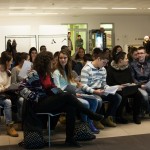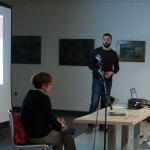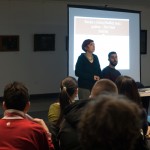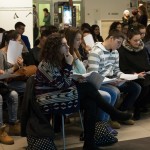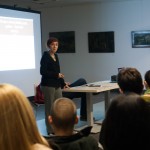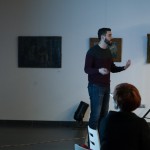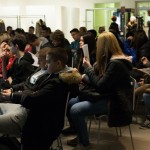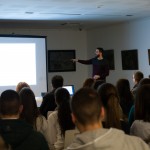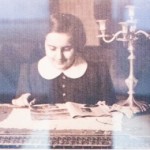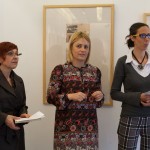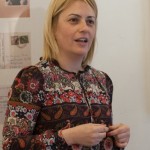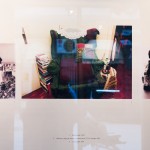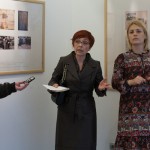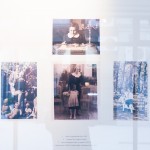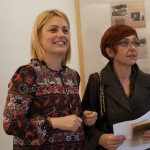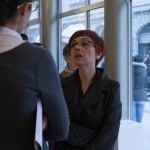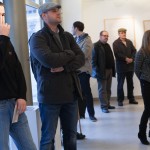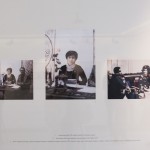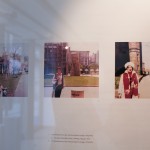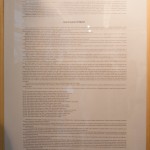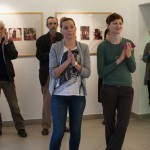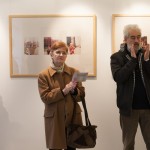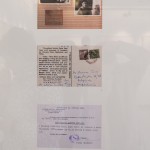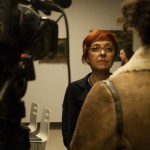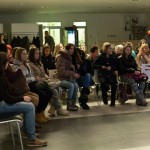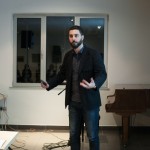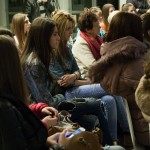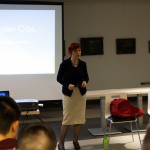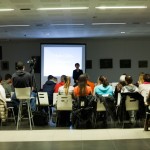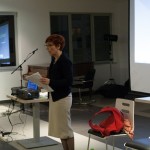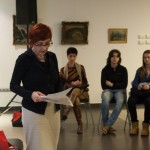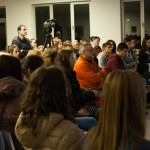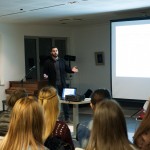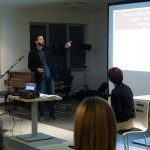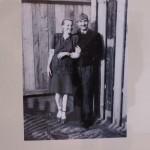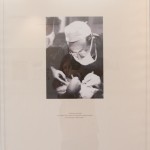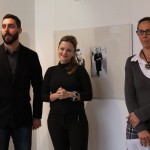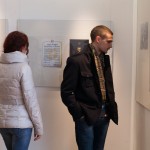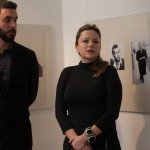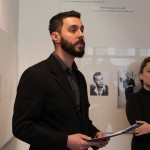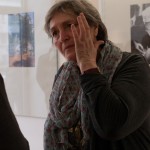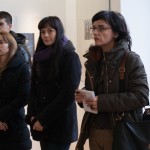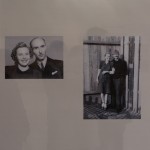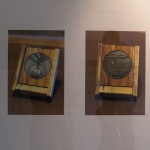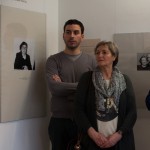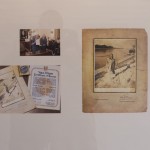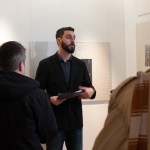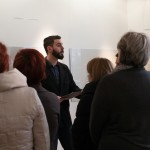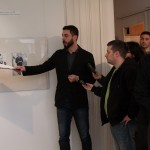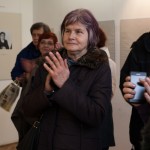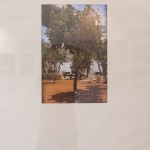Author: kcns
‘THE LIFE OF ILEANA ČURA’ – EXHIBITION
‘Mapping the City: Places of Suffering in Novi Sad’ – WORKSHOP
‘RIGHTEOUS AMONG THE NATIONS: NOVI SAD’ – EXHIBITION
‘RIGHTEOUS AMONG THE NATIONS: NOVI SAD’ – EXHIBITION
’HOW TO COPE WITH TRUMA AND HOW TO OVERCOME IT’ – WORKSHOP
Trauma and ‘Monument’ – key words of today’s workshop
Workshop by Gordana Todorić ‘How to cope with trauma and how to overcome it’, which was co-managed with psychologist Aleksandar Šibul, was held in the Great Hall of the Cultural Centre of Novi Sad within the programme ‘Freezing Silence Speaks’, dedicated to memory of the victims of Novi Sad Raid. Prior to the workshop there was a screening of ‘Monument’, film by Miroslav Antić.
Poet Miroslav Antić answer the question ‘How to cope with trauma and how to overcome it?’ through his film ‘Monument’. What is the role of culture and art in overcoming trauma, and what this film says about us today, are questions posed today in this workshop.
– Today, we directed our attention to thematisation of trauma and strategy of overcoming it. Primarily we talked about war traumas, but we also mention inter-ethnic tensions that existed between Serbs and Hungarians in Novi Sad and Vojvodina after the World War II. The second important thing is Antić’s film made in 1968. This year is very important for the art scene of Yugoslavia of that time, and that was the time which ended one very interesting and important period of very liberal attitude of the Government towards art production. Antić’s film, in those days, and in that context, discussed, through a personal view, love relationship between a girl and a boy from different ethnic communities. It speaks about overcoming trauma that some other people caused, on their behalf – said Ms Gordana Todorić.
Psychologist Aleksandar Šibul added that there are developmental traumas and so called shock traumas. Former occur gradually, primarily in families, and they are related to bad atmosphere, some types of child molesting, lack of emotions, arguments… All of these create a base for development of trauma that later has grave consequences.
– On the other hand, there are shock traumas that are related to certain events. They leave marks on families that lost their loved ones. Every violent and sudden death is a trauma, because processes between the loved ones are not over. Someone ‘leaves’, we have not talked enough, made peace, said goodbye… Shock traumas, like murder, strongly affect families, because the members of the family relive that memory each year and each year they are traumatised. Sorrow is passed down to next generation and that often leads to various diseases. Some of these are addictions – added Mr Šibul.
THE ENSEMBLE ‘SHEL K’FIR’ – CONCERT
Jewish music presented to citizens of Novi Sad
Young members of the quartet ‘Kol Shel K’Fir’ held a concert in front of the full Youth Forum, within the programme ‘Freezing Silence Speaks’ organised by the Cultural Centre of Novi Sad that commemorates the victims of Novi Sad Raid of 1942. The audience had a chance to hear a selection from their rich repertoire, and get to know Jewish music.
Founder and musical director of the quartet, musical artist and Master clarinet performer Leon Kajon, said that they mostly performed traditional melodies at the concert. There were songs with religious texts, arranged for quartet, classical compositions for dancing, some traditional songs performed at weddings… They wanted, as Mr Kajon said, to take a ‘piece’ from all spheres of life where you play music, and in that way show the whole spectrum of different types of Jewish music in order to give their own contribution to the manifestation that is of great importance for Novi Sad.
The quartet was founded in 2008 with the idea to bring Jewish music closer to non-Jewish population through specific arrangements that are of chamber music type, but the ensemble also holds concerts in certain clubs in a more relaxed atmosphere. Their goal is to make music that can be performed on various occasions. Current members are: Leon Kajon (clarinet), Julija Bal (piano), Bojana Jovanović (violin) and Mirjana Lalošević (cello).
Nikola Mihajlović – EXHIBITION
Exhibition of paintings by a victim of Novi Sad Raid
The exhibition of painting by Nikola Mihajlović, a victim of Novi Sad Raid, was opened in the Youth Forum of the Cultural Centre of Novi Sad within the ‘Freezing Silence Speaks’ programme. The exhibition was opened by the director of the Cultural Centre, Dr Andrej Fajgelj, and artist’s cousin and witness of the Raid, Mr Gavrilo Malenčić, was also present. After the opening speeches, senior curator and historian Čedomir Janičić personally showed the exhibition to the visitors.
The exhibition by the artist who perished in Novi Sad Raid is one of the opportunities to remember what culture was like in Novi Sad between the two wars. Visitors that came to the opening could see rare paintings that remain from this great artist and which represent his development in war painting.
Director of the Cultural Centre, Dr Andrej Fajgelj, said that this is one of numerous events with which this institution tries to fill the void in hearts of those who survived and who lost their loved ones in Novi Sad Raid.
– We fail to respect ourselves and victims and to ensure that sufferings that repeated several times in the past do not happen again in this century. Paintings that we can see remind us that suffering did not skip people who were artists, rich and educated. None of this could save them. It is very important to remember them, so that similar thing would not happen to us and our children – said Mr Fajgelj, adding that these paintings also show victims that must not be forgotten.
Nikola Mihajlović was born in Novi Sad and was a Serbian painter in late 19th and early 20th centuries that belonged to the modern art movement. At the beginning of the Great War he volunteered and went to war, and despite all misfortunes that happened he managed to paint, thus obtaining the epithet ‘war painter’. Unfortunately, there are few paintings that remain from this painter, because most of them were lost after the World War II. Paintings that visitors had a chance to see are in private ownership of the Malenčić family. Among exhibited paintings, there are portraits of his nephews Rodoljub and Gavrilo Malenčić, who disappeared immediately before Novi Sad Raid.
A cousin and one of the surviving witnesses of Novi Sad Raid, Gavrilo Malenčić, described what happend on that faitful day and how he survived by chance.
– I was a boy of only six and that day is vivid in my memory. Painter and my cousin Nikola Mihajlović lived within our house, and while our mother tried to save us by appealing to her Hungarian heritage, they had already taken my cousin and his family from the other house. We have not seen each other since that day – told Mr Malenčić, adding that a month after the Raid he went out of the house and that he could still see marks of that horrific act in snow.
‘RIVER OF MEMORIES’ – INSTALLATION ON THE LIBERTY SQUARE
Strong symbolism in honour of the memory of the Raid victims
‘River of Memories’, the installation of sculptor Ljubomir Šćepanović, which is part of the programme entitled ‘Freezing Silence Speaks’ organised by the Cultural Centre of Novi Sad that commemorates the victims of Novi Sad Raid, was placed on the Liberty Square.
The installation is made of white rocks, 10 cm in diameter, and structures of rectangular shape of different sizes. Geometrical shapes are made of metal which was welded together and painted black. On the surface of rocks is inscribed with names of the identified victims of the Novi Sad Raid and how old they were.
– This composition symbolically represents river flow passing by the city, and the city represents people. Symbolically, in this installation, victims (rocks with names) are river. Last year we also made an installation using these rocks; those were concentric circles that symbolised holes in ice. My idea is to use these rocks with names of victims every year during commemoration of the Raid for installations, but to arrange them differently – said Mr Šćepanović.
Dynamics within the composition, represented through white rocks, symbolises the flow of life, i.e. a river. The river is a crucial element of the composition given that it evokes strong emotion because it is a reminder of the fact that the victims were thrown under ice, beneath the water surface in the icy Danube that runs through Novi Sad. Metal objects of rectangular shape represent the city of Novi Sad and are placed next to the inscribed rocks that represent the river flow. Together they make composition of shapes and surfaces, which is an artistic view of events that happened on that day. Shapes and the installations represent river (people), Novi Sad (metal objects) and victims (river) that died on that day during the Novi Sad Raid.
We would like to remind that last year, also within the commemoration of the victims of the Novi Sad Raid, the rocks inscribed with names of the victims (Serbs, Jews and Roma) were placed on the Liberty Square. According to Jewish tradition, a rock is placed at a cemetery as a memory of the dead because a rock lasts forever, while flowers whither. The same author participated in making last year’s installation.
‘Memories of Ileana Čura: film and discussion about the film” – WORKSHOP
Memories that never fade
The film about the life of Professor Ileana Čura Sazdanić was shown as part of the third workshop in the Cultural Centre of Novi Sad in the Youth Forum, within the manifestation ‘Freezing Silence Speaks’. The author of the workshop Gordana Todorić and historian Stefan Radojković spoke about personalisation viewed from two angles – of those who survived and those who conducted Novi Sad Raid.
Following the first workshop where audience had a chance to see where this crime happened and the second where they saw which texts preserve memory of the Raid, the third workshop was about personalisation. The author Gordana Todorić said that the entire life story of Ileana Čura is not tied solely to Novi Sad Raid. Ms Ileana and her family are written in golden letters in the history of Novi Sad.
– To personalise means to attribute real characteristics to a name. First of all, it is important to learn what it means to lose a human life, even if this is not an intellectual, or a high ranked person, or a person whose parent are not famous. In this concrete case the loss is great, but Professor Ileana Čura continued the tradition of her family, by learning, expanding knowledge and borders, connecting with people, and these are fundamental human values – said Ms Todorić.
After film screening, the audience was addressed by Ms Ileana Čura via telephone. She thanked them for coming and in that way expressing compassion with the victims of Novi Sad Raid.
– Positive thoughts in situations when the evil is present in the world mean a lot to an individual. These are the days that take us back to the past, which is embedded in our present. We should try to forgive, but not forget, because each person should work on him/herself and should develop in his/her consciousness an approach to life that is filled with good and to pass it to wider community – said Ileana Čura, and after that the audience expressed their interest to ask her questions.
The film about Professor Ileana Čura, who survived Novi Sad Raid by chance, is not just a reconstruction of her personal biography, but of family the members of which marked the map of the city with their deeds. After the workshop, the visitors went to the Art Gallery of the Cultural Centre to see the exhibition of photographs, memories and personal belongings of Ileana Čura. In these photographs they could see short display of her life, which was very exciting and eventful.
COMMEMORATIVE PLAQUE TO THE ČURA FAMILY IN KING ALEKSANDAR STREET
Placing of the commemorative plaque to the Čura family
In King Aleksandar Street no. 1, as part of commemoration of 73 years since the Novi Sad Raid, a commemorative plaque was revealed, dedicated to the Čura family, 16 members of which were killed on 23 January 1942 in Novi Sad and Čurug.
– We who create politics must develop the culture of remembering, so that we never forget the victims, and we should work on tolerance in order not to repeat these sufferings in the future – said Vanja Vučenović, member of the City Council in charge of culture.
The plaque bears names of the victims, and on the bottom is a line by Isidora Sekulić: ’Life may be short, but memory of a life can last forever’.
Writer, lawyer and the president of ‘Adligat’ association, which launched the initiative to place the plaque, Viktor Lazić said that it is his wish to open a museum of Novi Sad Raid, as well as that this commemorative plaque is the first big step towards achieving this goal.
– The Čura family lost 16 of its members. Nadežda Čura and Ljubica Sazdanić were taken from this building to be brutally murdered. This was a great tragedy and I think that it is extremely important, for the culture of remembering, that this plaque was placed – said Mr Lazić.
‘Text as testimony of the Raid; history, memoirs, fiction’ – WORKSHOP
Analysis and approach to a text as part of education process
Workshop ‘Text as testimony of the Raid; history, memoirs, fiction’ by author and teacher Gordana Todorić was held in the Youth Forum of the Cultural Centre of Novi Sad. Historian Stefan Radojković complemented Ms Todorić’s lecture with historical facts. Written testimonies about the past – historical, memoir and literary, acquire their meaning only after they have been read and thought about.
Visitors of the second workshop participated interactively and at the very beginning they got texts for discussion. Excerpts from books by Zvonimir Golubović, Dina Rajs, Lea Ljubibratić’s interview, excerpt from the novel ‘Hourglass’ by Danilo Kiš and a poem by Ružica Galac Popović, are some of the texts that were read and that are related to the Novi Sad Raid and events that occured in those days in Novi Sad.
Gordana Todorić, the author of these workshops, familiarised visitors with the text as a document that can help in revealing and getting to know how horrific event the Raid was. Visitors, among which there were students of high schools in Novi Sad, could learn how to approach a text from different angles, and how to perceive all characteristics that a domestic source offers while reading it.
– When we read these texts today, we know that they are different in nature and structure. Therefore we must approach them in different ways. The present time has quite complex view of a text and text-centricity of culture. The most important question for me is – How do we train someone to approach a text? – said the author and added that the very way we approach a text and its analysis are part of the education process.

